Historic sites and sites of interest
Historic sites and sites of interest
CHURCH OF SANT’ERMETE
From the very beginning of settlement in Forte, the inhabitants felt the need for a regular place of worship where they could go to pray and attend services. A small church was built on what is now Via Duca D’Aosta – but construction of today’s church, with its bell tower, was not begun until 1890. In 1911, Sant’Ermete was elevated to the status of independent parish church by Cardinal Pietro Maffi, so obtaining its independence from the Pievania of Querceta, and was officially dedicated to Saint Hermes Martyr, as Sant’Ermete, patron of Forte dei Marmi.
CHURCH OF SAN FRANCESCO
Località Vittoria Apuana
As had been the case in Forte dei Marmi, when the Vittoria Apuana locality began to expand following subdivision several tracts of land, construction of a designated place of worship became a pressing need. The locality’s church, dedicated to Saint Francis, was built between 1926 and 1933. The stone used in construction, which concluded before the bell tower could be raised, includes marbles from the nearby quarries in the Apuan Alps; the marble still makes a fine showing in the window frames and molding, the floors, the columns, and the altar. The plaza in front of the church hosts a sculpture by Carrara native and Forte dei Marmi resident Arturo Dazzi, inaugurated in the presence of the artist. The work, sculpted from a single block of marble, recalls the episode of Saint Francis and the wolf.
PIAZZA GARIBALDI
The well in Piazza Garibaldi, the Fortino’s square, was sunk in 1842 and is still in the same spot. Its waters provisioned departing ships and filled the troughs for watering the draft animals that pulled the wagons, private carriages, and coaches transporting goods and passengers to Forte.
The fountain in the square, installed in 1900, still bears the emblem of the Comune di Pietrasanta and the inscription: “The Municipality of Pietrasanta and its Mayors Puliti and Frullani, by completing the Andreotti project, intend to enrich Forte dei Marmi with abundant and healthy water.” Since then, the fountain’s cool fresh water has never ceased to slake the thirst of residents and visitors alike.
Arturo Dazzi’s Vittoria, installed just outside the Fortino, was sculpted in 1938. The marble basin at the statue’s feet was once used for watering the oxen and horses that transported stone from the mountain quarries to the sea.
PIAZZA DANTE
Also known as “Piazza della Rimembranza” in remembrance of the fallen of all wars, Piazza Dante is home to the Monumento ai Caduti sculpted in travertine by Mario Figliè. The square’s gardens provide a pleasant venue for fairs and antique markets and frame the majestic building, raised in 1922 to serve as a lower school and then the Liceo Scientifico Michelangelo, which today is the Forte dei Marmi City Hall.
THE FORT OF PIETRO LEOPOLDO I OF TUSCANY
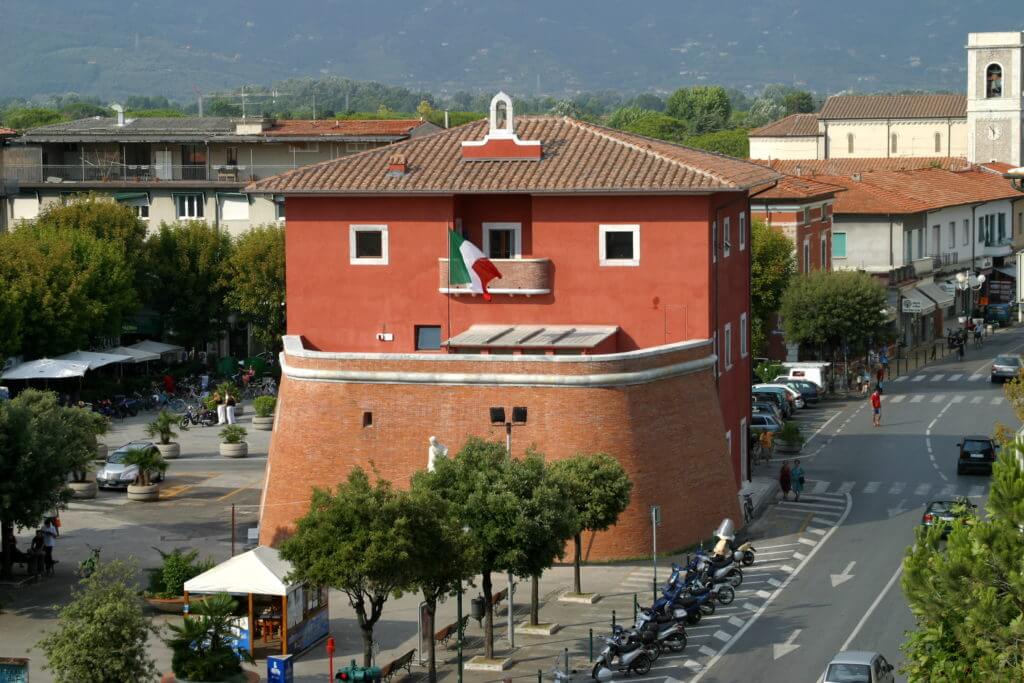
Piazza Garibaldi
Comune di Forte dei Marmi Ufficio Cultura ed Eventi (Office of Culture and Events) Phone: +39 0584 2801
For information and opening hours, phone: 0584280292 e-mail: forteinfo@comunefdm.it
As you stroll through the historic streets of the Forte dei Marmi center, it is hard not to recognize the squared-off shape of the Forte Lorenese (universally known as the “Fortino”), which began life as a fortification “at the marble wharves” ordered raised by Pietro Leopoldo I, Grand Duke of Tuscany, to defend against pirate incursions. Completed in 1788, it lent its name to Forte dei Marmi and is a symbol of the city.
The iconic reinforced and round-cornered bastion on the seaward-facing side defends supports three stories and, on the roof, a small tower for raising the flag and a chimney for signaling danger with smoke. The structure stands at the center of a large plaza, today’s Piazza Garibaldi, which was the hub of the seagoing trade in marble and in goods from coming down from the inland hills. During its history, the Fortino has also been used as a customs house, as housing, as guards’ barracks, as kitchens, and for drinking water storage. More recently, it was the headquarters of the Guardia di Finanza, the Delegazione della Spiaggia, and the Post Office. In 1988, the Fortino was acquired by the municipality; following extensive restoration, it is now a venue for prestigious exhibitions and cultural events.
VILLA BERTELLI
Via Mazzini, 200
www.villabertelli.it
For info and opening hours, phone: +39 0584 787251 e-mail segreteria@villabertelli.it
Villa Bertelli, built in 1896 in the center of the Vittoria Apuana locality, was the headquarters of the Società Italiana Prodotti Esplodenti (SIPE) and boasted its own wooden pier for loading and shipping its explosives abroad. At the close of World War I, the immediate demand for arms and ammunition drastically decreased; consequently, and in response to the wishes of the city council of the time, it was decided to promote tourism over industry. SIPE soon closed; the pier was demolished in about 1930. The building was purchased by Ilio Bertelli in 1926 and converted for use as accommodations with the name of Pensione Bertelli. The villa’s life as a hotel came to an end in 1971; in the early 2000s, the Comune di Forte dei Marmi purchased the property and total restoration to plans by architect Tiziano Lera transformed it into a capacious exhibition space. Cultural events and shows of various types are held all year round in the villa’s rooms and in its surrounding gardens and park.
MUSEO UGO GUIDI
Via Matteo Civitali, 33
phone: +39 0585 348510
museougoguidi@gmail.com
Visits by appointment: mobile +39 348 020538
The Museo Ugo Guidi in Località Vittoria Apuana is sited in the house in which the artist lived until his death on 10 July 1977. Ugo Guidi was born on 14 September 1912 in the Querceta locality of Seravezza; he studied sculpture and architecture at the Istituto d’Arte of Pietrasanta and the Accademia di Belle Arti of Carrara, where he remained to teach sculpture. He presented his first one-man show only in 1956, in Florence, encouraged by Ottone Rosai. Several of his works have been exhibited at the Hermitage Museum of Saint Petersburg and in various other museums by request of the Italian Foreign Ministry; one hundred of his drawings have been donated to the Uffizi’s Department of Prints and Drawings; several of his sculptures are on show at Florence’s Palazzo Pitti, at Rome’s GAM, at the Museu Olímpic i de l’Esport of Barcellona and at the Consejo Superior de Deportes of Madrid. The Guidi house-museum organizes exhibitions of contemporary art and meetings addressing themes in culture and art.
THE PONTILE
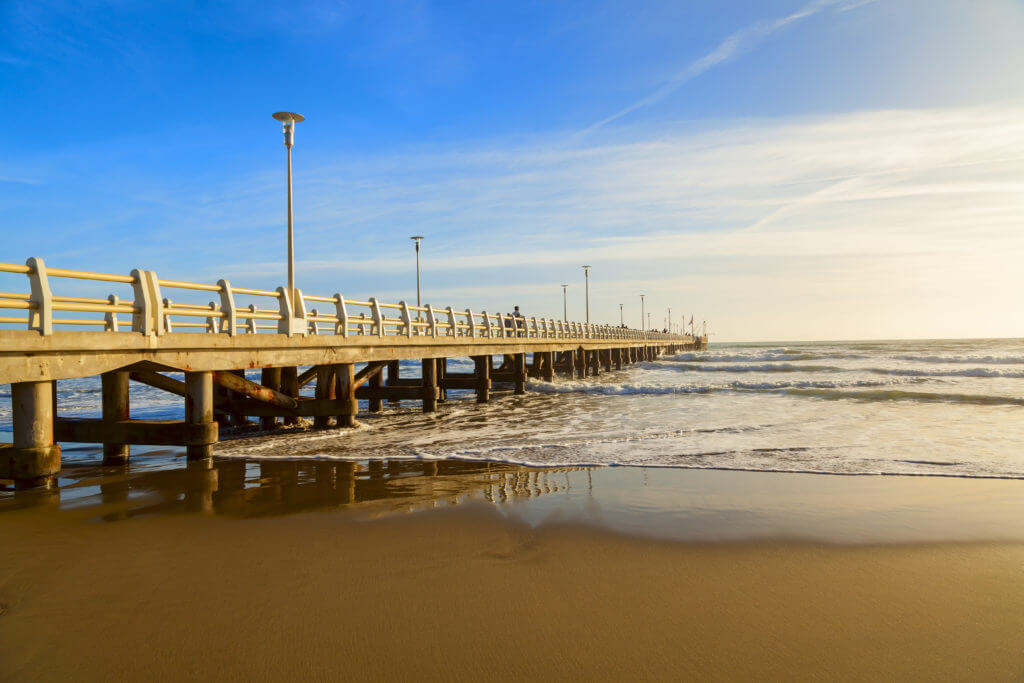
“Without the Pontile, we of Forte dei Marmi would lose our bearings”
— Fabio Genovesi, writer
From the end of the Pontile, a glance ahead to the sea and another back over your shoulder, to the mountains, tells the whole story of Forte dei Marmi. When Forte became so important a port for the marble trade that it was no longer practical to load the blocks onto the merchant ships from the beach, a long pier was built to transport them over deep water. It was 1788 and the first pier, built to plans by Giovanni Costantini, was 5 meters wide and 325 meters long. The wooden structure was fitted with tracks along which the loading carts ran, powered by a steam engine, to the loading crane nicknamed “La Mancina” at its end. Around 1930, the pier was lengthened and equipped with a gate and a small guardhouse, but was destroyed a little over a decade later, during WWII. It was rebuilt in 1955, in reinforced concrete, and it is in this guise that it has come down to us.
In 1986, the Compagnia della Vela sponsored recovery of what was left of the crane; the parts were transformed into a monument to the workers of the sea installed in the pinewood at the corner of Via Spinetti and Viale Italico.
Today, the Pontile is frequented by fishermen, artists, residents, and tourists; in the summer it hosts outstanding cultural, musical, and society events – as well as the August 28th fireworks display celebrating Forte’s patron saint, Sant’Ermete. The structure is a paradise of peace and poetry, a singular lookout on the panorama of the sea, the Apuan Alps – from Monte Sagro to Monte Matanna, courtiers to the majestic Monte Pania – and indeed the entire arc of the coastline from La Spezia’s archipelago south to Viareggio and beyond.
THE "MANCINA"
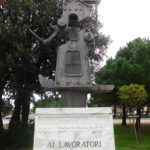
“What a traffic around the Pier! There is a continual coming and going of ships, marble blocks and men. Everything is dominated by the Mancina.”
(from the book “La Bibbia di Forte dei Marmi” by Giorgio Giannelli)
La “Mancina” was a powerful crane set on the pier of Forte dei Marmi in 1877; it was so called because of its rotating movement to the left-side. The crane was used to load marble blocks on the ships. In September 1943, during the occupation of the German army, the pier was completely destroyed because it was considered a good point where the allied troops could land. La “Mancina” sank in water.
The first attempt to rescue the crane was performed by the divers Giuseppe Lottini and Enrico Bocompagni. On 24th November 1993, Giuseppe Foffa, chairman of the Association of Seaworkers, resumed the rescue operation in order to realize a monument for the “Mancina”. The memorial, based on the project of the architect Tito Salvatori, was inaugurated on 1st May 1995. Among the promoters we remember Emilio Barberi, Gold Medal for Military Valour, Captains Ettore Polacci and Galliano Raffaelli, Luciano Figliè and Luciano Luciani.
The memorial gathers the various parts, half destroyed and broken (the main shaft, the gears scaffold, part of the gearwheel) of the crane. The marble pedestal, accomplished by Ennio Bazzichi, building contractor, depicts the hard work needed to move the marble blocks from the quarries to the sea in the three low relieves projected by the sculptor Rino Giannini.
The latest rescue of the Mancina was carried out in January 2017 by the Divers Association of Forte dei Marmi with its chairman Primo Cardini; during a diving inspection they pinpointed the missing mechanical arm of the crane which is still underwater.
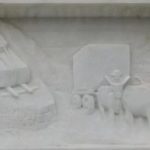
In the first low relief the sculptor Rino Giannini portrays marble mining in the quarries. In the second level the“lizzatura” is depicted. The term “lizzatura” is referred to the way of transport of marble blocks from the quarries to the sea, since the Egyptian era to the 1960s . The name” lizzatura “comes from the sledge (“lizza”) on which the marble blocks were tied and then they glided on wooden boards along the way towards the“poggio”, a sort of step used to load the blocks on the “barroccio”, a wooden cart led by oxen. In the first level the artist depicted a locomotive which comes out from the tunnel “Cipollaio”, through which the railway arrived to Forte dei Marmi from the quarries ; only later it was used as common road.
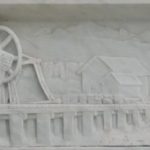
In the second low relief, the Artist depicts the barroccio or membrucca near the fort ,“Fortino”, (today Piazza Garibaldi) where the blocks and slabs waited to be loaded on the ships (navicelli). The blocks were loaded on the “barroccio” while the “mambrucca”(a wagon with sideboards) was used to load the slabs. In the background you can see the well, which provided supplies of water for the ships and was used as well to water the animals; the fountain, called “Nasone” (big nose); and the café, Quarto Platano, where artists and intellectuals met, a ship set on poles waiting to be repaired and finally a trolley on rails as symbol of industrial development.
The writing “ ai lavoratori del mare” ( to seaworkers) fully expresses the message that the citizens of Forte dei Marmi want to remember through the “ Mancina”, in memory of the hard work done in a time long gone and of a village by the sea grown around the “Fortino”.
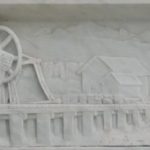
In the third low relief, the artist portrays the fort “Leopold I” and the bell-tower of the church of S. Ermete. The ships on the beach suggest a festive day. In this scene the “Mancina” is highlighted through the pier’s perspective and the vanishing point towards the mountains virtually brings us back to “Via di Michelangelo, the road where it all started. The departing ship seems travelling towards the future up to the present day to remind that the “Mancina” is an important piece of the history of Forte dei Marmi.









